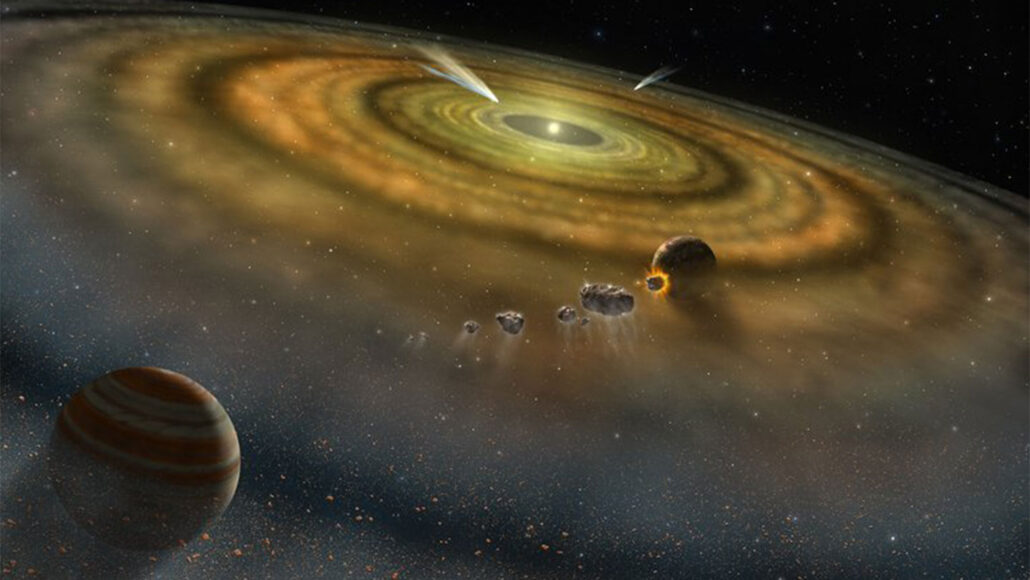Possible title: Potential Link Found Between Destabilization of Giant Planet and Formation of Earth's Moon

The ancient rearrangement of the immense planets in our solar system might have played a significant role in giving Earth its moon, according to recent findings.
Planetary scientists have theorized for many years that Jupiter, Saturn, Uranus, and Neptune originated nearer to the sun and were later propelled into their current paths by gravitational forces between them (SN: 5/10/22). However, determining the exact time of this "giant planetary orbital instability" has proven challenging.
Presently, a study of meteorite data proposes that the instability happened between 60 million and 100 million years after the solar system's inception, as revealed by planetary scientist Alessandro Morbidelli on October 5 at a meeting of the American Astronomical Society's Division for Planetary Sciences in San Antonio. This period roughly aligns with when Earth's moon is believed to have formed following a collision with a Mars-sized planet.
According to Morbidelli, from the Observatoire de la Côte d'Azur in Nice, France, the giant planet's instability correlates to a comprehensive redesign of the solar system, including the cometary reservoir creation and asteroid belt sculpting. Knowing its occurrence helps set a key point in the solar system's history.
The theory of giant planet migration, first put forth by Morbidelli and others in 2005, is commonly accepted as an explanation for much about the solar system. It proposes that gravitational interactions gradually sent the planets into today's orbits, even if the giant planets initially formed along close, circular, and coplanar routes.
Initially, the team thought the instability happened about 600 million years post the solar system's birth. This timeline suggested the migration of large planets could explain apparent asteroid bombardment of terrestrial planets - Mercury, Venus, Earth, and Mars - as shown by moon craters and lunar rocks. However, recent work cast doubts on this “lunar cataclysm” theory.
Morbidelli currently thinks the orbital instability occurred much sooner. His belief is based on a rare type of meteorite known as EL enstatite chondrites.
The composition of these meteorites suggests they originate from a large rocky entity born near terrestrial planets in the dusty disk around our sun. Morbidelli and team showed in 2022 that these chondrites landing on Earth today must be from the asteroid belt between Mars and Jupiter, specifically from Athor, which was part of a larger rocky body destroyed in a collision closer to the sun.
The key question Morbidelli raised at the meeting was: what dynamical mechanism could allow Athor to end up in the asteroid belt?
Computer simulations of several possibilities point toward giant planet instability as the only probable cause for shifting Athor to a stable orbit in the asteroid belt.
According to Morbidelli, this could not have taken place earlier than 60 million years after the solar system's birth as the parent body of the enstatite chondrites was still cooling, implying it was yet intact. Simulations also suggest the instability could not have happened later than 100 million years after the solar system's birth. A 2018 study asserted that any later migration of the giant planets would have dismantled the asteroid pair Patroclus-Menoetius, which follows Jupiter around the sun while also orbiting each other.
That 60-million- to 100-million-year window makes the instability a prime suspect in the diversion of a hypothesized planet that hit Earth, creating the moon (SN: 3/15/23). The timing “seems right,” says Matthew Clement, an astrophysicist at the Johns Hopkins Applied Physics Laboratory in Laurel, Md. “Lots of things were happening in the solar system’s early history. However, dynamically speaking, we don’t have a whole lot of reason to believe that things changed much after the moon-forming impact.”
But he cautions that Morbidelli’s estimate is based on “one data point, of the breakup of one asteroid, pieces of which serendipitously happened to get to Earth.”
Still, “it’s nice that [the new result] is actually based on some real data, even if it’s indirectly, rather than just computer models,” says planetary scientist John Chambers. He has questions, though. “They suggest this happened when the formation of the terrestrial planets was more or less complete, apart maybe from the giant impact that formed the moon,” says Chambers, of the Carnegie Institution for Science in Washington, D.C. “But then there’s a good chance it would have messed up the orbits of the terrestrial planets and possibly led to some of them colliding,” which the current lineup of planets suggests did not happen.
Both Chambers and Matthews have worked on scenarios in which the orbital instability occurred even earlier, just a few million years after the solar system began. That earlier time for the instability would help explain one of the outstanding riddles of the solar system: the relatively small size of Mars compared with Earth and Venus. That’s because the instability would have removed many objects from near the orbit of Mars before it could grow to the size of Earth or larger. The new result from Morbidelli’s team seems to exclude that solution.
“I’m prepared to rely on the evidence,” Chambers says. But he isn’t convinced yet because many facets of the solar system’s present structure must be reconciled with any date for the giant planet instability.
Clement agrees. “There’s problems if the instability happened at 500 million years. There’s still problems that we have to resolve if it happened when they say it happened,” he says. “And there’s still problems if it happened immediately after the planets formed, in the first few million years. This story is not done being told yet.”
This article was supported by readers like you. Invest in quality science journalism by donating today.




